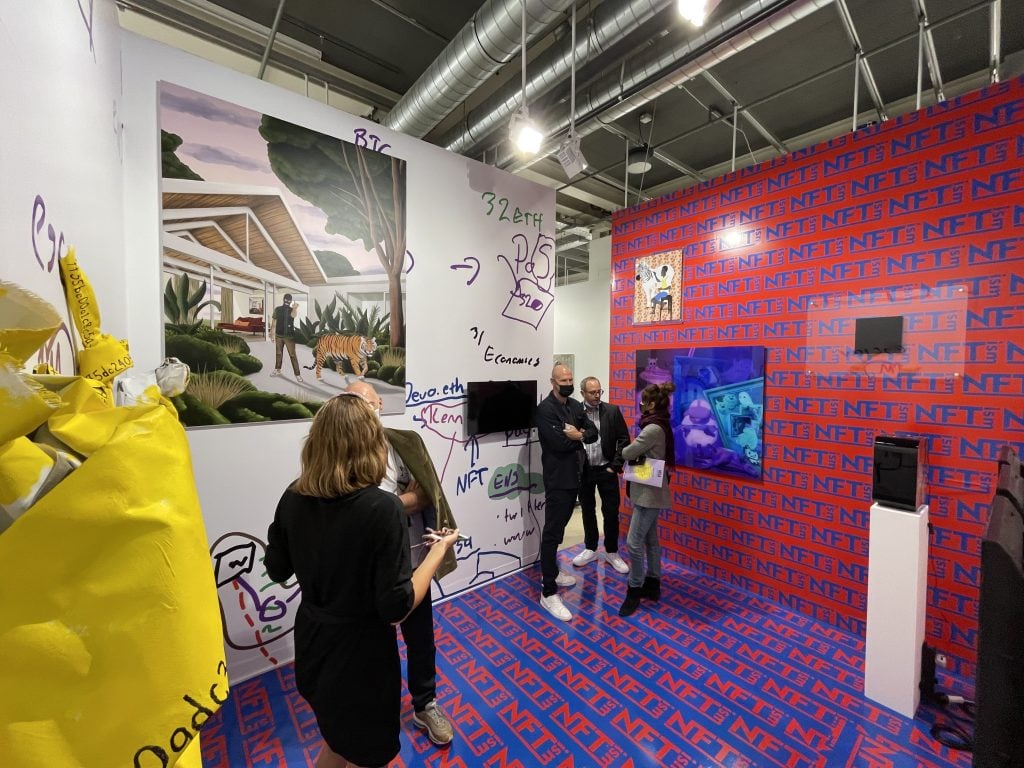Art Fairs
NFTs Make Their Debut at Art Basel, Where Collectors Are Curious—And a Bit Confused—About the New Art Medium
Galerie Nagel Draxler reported strong sales of its NFT offerings, finding workarounds for collectors without crypto wallets.

Galerie Nagel Draxler reported strong sales of its NFT offerings, finding workarounds for collectors without crypto wallets.

Kate Brown

A gentleman in a navy blue crushed velvet suit emerged from Galerie Nagel Draxler’s “Crypto Kiosk” on preview day at Art Basel shaking his head. It was hard to tell whether behind his mask his face was disappointed or confused.
The kiosk marked the first major attempt to insert the newest vanguard of art objects into this central node of the art industry. It has brought interesting conversations to the gallery’s booth in the main section of the fair, leaving more than a few collectors new to the format curious, and others quite puzzled.
Nagel Draxler’s usual backroom has been transformed into a physical outpost of the digital world of NFTs, an extension of a recent exhibition called “NFTism” that the gallery organized with Kenny Schachter (who also happens, of course, to be an Artnet News columnist). The eight-artist display in Basel is punctuated with bold blue and red floor-to-ceiling wallpaper, and the gallery’s various physical interpretations of NFTs, which it created in collaboration with the artists of “NFTism.”
Another VIP had his iPhone and cable dangling in his hand, searching for a place to charge up behind Mosaic Virus, a work by Anna Ridler that is on view in the booth but for sale on OpenSea.
The gallery politely let him know that he may not do so. “It has been interesting to bring NFTs into a fair context,” said Denise Kokko of the Cologne and Berlin-based gallery. “We cannot even sell the works here… It’s a somewhat conceptual approach.”

A view from the booth on preview day. Photo: Kate Brown
Throughout the pandemic, when physical art events were on hiatus, NFTs have been soaring in popularity. NFT news has trumped art market news with record-setting numbers, stoking shock, awe, and dismissive eye-rolls from art world gatekeepers—except for the few who have spotted new opportunities.
Despite the waves made, there remained a noticeable dearth of the new takes on digital art at Art Basel. “In two or three years it will be the norm to see such works beginning with Pace, who have already launched their own platform,” Kenny Schachter said. “Every gallery with a website will be minting NFTs in no time; if not from the foresight of the gallerists, then at the insistence of their artists!”
Despite the difficulty of the proposition for now, Nagel Draxler reported success with NFT sales, and its little booth offshoot was packed with VIPs on preview day. Olive Allen’s Post-death or The Null Address NFT sold for 8 ethereum, about €25,000, on opening day. An edition of Ridler’s Mosaic Virus—a beautiful three-screen piece depicting floating tulips and their bulbs, a nod to the plant that became an object of hyper-speculative boom-and-bust centuries ago—sold for £20,000. Kevin Abosch’s NFT had sold for approximately €40,000 by early evening on preview day.
Collectors were hoping to buy works right off the wall, as they normally do. The dealers, however, had to divert them to OpenSea, the popular crypto platform where NFTs are bought with cryptocurrency. Nagel Draxler did, however, make a few exceptions on preview day, allowing some clients to pay in euros or dollars via the usual decades-old invoice procedures. In agreement with the artists, the gallery then purchased the work with their own wallet on the platform to close the sale.
“Some traditional collectors are totally not familiar with these procedures,” said Kikko. “So we made an exception. We are trying to make NFTs accessible.”